Is there anything in the world of food more appealing than a gloriously fresh pesto, with its vivid green color and bright, bold flavor?
I can’t think of anything more wonderful in early spring than this sometimes chunky, sometimes smooth sauce with its heady aroma and visceral connection to the earth and all things leafy green.
Almost any raw herb, leafy green, or vegetable can be turned into pesto–a simple, fresh, uncooked sauce consisting of the aforementioned greens, nuts, aged cheese, and oil. Additional ingredients can be added to these basic elements. Or, conversely, the cheese or nuts can be omitted. The options seem nearly limitless.
I was struck by a new surge of pesto love Saturday morning while taking in the bounty at Portland Farmers Market–on the campus of Portland State University. Just harvested bunches of local cilantro, arugula, chives, sorrel, spring garlic, scallions, plus organic walnuts and hazelnuts were calling my name–which of course I answered by loading up my metro cart with all of them.
Then I happened upon the vendor, Pesto Outside the Box, and tasted my way through their beautifully crafted collection of pestos: Basil, Garlic & Chive, Chipotle, and Cilantro Pistachio. When you don’t feel like making your own pesto, this option is definitely on a par with the best you can make in your own kitchen.
A Little History
Hailing from Liguria in northern Italy, pesto is perhaps the quintessential pasta sauce—fresh, cheap, flavorful, and imminently satisfying. Traditional Italian pesto is made from fresh basil (with perhaps some parsley), garlic, Parmigiano-Reggiano, pine nuts, and olive oil, all staples of the region. In Provence, France, a similar mixture is called Pistou, which may contain cheese but usually no nuts.
In North America, cooks have been going wild with pesto since its debut on these shores in the 1980’s. And by wild, I mean No Holds Barred, Anything Goes. Check out the 562 pestos featured on TasteSpotting, which include Asparagus Pesto, Pistachio Pesto, Cilantro & Roasted Pepper Pesto, Parsley Fennel Pasta, Sun-Dried Tomato Pesto, Artichoke & Hazelnut Pesto, Curly Kale Pesto, and Asian Pesto. And these are just the tip of the proverbial iceberg.
But what’s missing for me in all this creative exuberance is a sure-fire formula. What is it that makes pesto, well, pesto? What are the essential ingredients? What are the ideal proportions of these ingredients? A pesto GESTALT if you will. So that’s what I set about to create.
Experiment With It
Within certain boundaries that keep me within the pesto corral and hopefully prevent me from wandering into the salsa, chutney, relish or chimichurri corrals, I am continuing to expand my pesto horizons. I settled on the proportions in the Basic Pesto below, which work perfectly with most of the leafy greens I managed to pulverize this past year.
The largest variable for me is how much oil to use. In the recipes below, ½ cup of oil makes a very thick pesto. If you need a thinner pesto, simply increase the quantity of oil to 1 cup or so.
Whether I include cheese or nuts, or both, depends on what I intend to do with the pesto. Nuts add an earthy element, while cheese adds a savory element. It’s a matter of harmony or contrast with the key elements of the dish to which the pesto will be added.
And then, of course, there’s the textural element. Pesto can be almost as smooth as butter or as chunky as roughly chopped herb relish. I tend to prefer chunky, but, again, that decision is yours.
How to Use Fresh Pesto
But what do you do with pesto once you have it on hand? That’s easy!
- Toss it with freshly boiled pasta or spaetzle.
- Stir it into polenta.
- Spread it on crostini.
- Melt it over steamed veggies,
- Slather it on a sheet of bread dough and roll up.
- Blend it with cream cheese or goat cheese for a vegetable dip.
- Add it to toasted bread crumbs and top a casserole with it.
- Spread it on a fish filet before roasting.
- Smear it on pizza.
- Add it to risotto.
- Melt it onto a baked potato.
- Add it to a fritter batter.
- Swirl it into hot soup.
- Add it to a vinaigrette.
- Stuff it under the skin of a chicken breast before baking,
- Fill an omelet with it.
- Add it to popped corn.
- Dress a potato or pasta salad with it.
- Add it to steamed clams or mussels.
- Freeze it in tablespoon-size dollops for later use.
And these are just the beginning.
Basic Pesto
This pesto formula is well balanced, with nuts in the starring role and a dry grating cheese in the supporting role. You can reverse or alter these two proportions for a slightly different effect, if you wish. You can also go light or heavy on the oil, which, along with whether you chop or puree the other ingredients, will determine the consistency of the sauce.
Equipment Note I use a food processor to make pesto, but you can use a more traditional, large mortar and pestle if you like. Even a large mortar and pestle, however, will only accommodate a quarter portion of any of the recipes below. Also, it works best to chop everything coarsely before adding to the mortar.
Ingredient Note The disadvantage of using basil as the only leafy green is that it has a tendency to discolor when pureed, turning from a lovely bright green to a somewhat less lovely olive green when exposed to air. To mitigate this, I usually partner it with parsley, which holds its color.
Olive Oil Note Extra-virgin olive oil contains bitter tasting polyphenols, which don’t usually assault your taste buds because they are coated with fatty acids. The fatty acids hold the polyphenols in check. Extreme agitation, as with a processor or blender, releases the full bitterness of the polyphenols. Polyphenols can wreak havoc with mayonnaise, vinaigrette, and pesto, lending a sharply bitter aftertaste. So after many bitter batches of pesto, I now use either light olive oil or flavorless vegetable oil. Lesson learned.
1 cup nuts (walnuts, hazelnuts, almonds, macadamia nuts, pumpkin seeds, or pine nuts; lightly toasted is nice)
2 cups packed fresh leafy herbs or greens (basil, parsley, spinach, sorrel, or arugula, either singly or in combination, plus perhaps mint, oregano, rosemary, or lemon verbena)
½ cup grated Parmigiano-Reggiano, pecorino romano, grana padano or dry asiago cheese
2 large garlic cloves, peeled
1 tablespoon premium-quality vinegar (or fresh lemon or lime juice)
½-1 cup light olive oil (or grapeseed, walnut, hazelnut or other oil)
½ teaspoon fine sea salt, or more to taste
- In a food processor, chop the nuts, herbs, Parmesan, garlic, and vinegar until coarsely chopped.
- With the machine running, slowly add the olive oil and process until the desired consistency.
- Add salt to taste..
- Remove pesto to a container, seal, and refrigerate until ready to serve.
Makes 1-1½ cups.
Pesto Oil
Occasionally I want the flavor of pesto but none of its texture. For this, simply add an additional cup of oil to the completed pesto, macerate for ½ hour at room temperature, and then strain the oil through a triple mesh strainer. The mixture that is left in the strainer is still wonderfully flavorful. Simply add a little oil back to it to get the desired consistency.
Rosemary Hazelnut Pesto
This no cheese pesto is a contrast of flavors: the toasty earthiness of the hazelnuts, fresh sprightliness of the parsley, and pungency of the rosemary and garlic. Add lemon, and BAM!
Technique Note As is, this pesto is about the same consistency as traditional basil pesto, which is perfect for saucing pasta or spaetzle, or slathering on crostini. However, you can also take a portion of it and add enough additional oil to make the pesto thin enough to drizzle over soups–a very pretty effect. You can even add considerably more oil and then strain the oil off to get a gorgeous and tasty green oil to garnish the most sophisticated dinner plate.
1 cup hazelnuts, lightly toasted and skinned
2 cups packed fresh flat-leafed parsley leaves (1 small bunch)
leaves from 1 medium sprig rosemary
2 large garlic cloves, peeled
finely grated zest of 1 large lemon
1 tablespoon fresh lemon juice
½-1 cup light olive oil
½ teaspoon fine sea salt, or more to taste
- In a processor fitted with the steel blade, process hazelnuts, parsley, rosemary, garlic, lemon zest, and lemon juice until coarsely chopped.
- With machine running, slowly add olive oil and process to desired consistency.
- Add salt to taste.
- Remove pesto to a container, seal, and refrigerate until ready to serve.
Makes 1-1½ cups.
Garlic Scapes, Basil & Lemon Pesto
When spring hits Northwest farmers markets, garlic scapes are the first thing I grab. Garlic scapes are the flower bud of the garlic plant. The bud is removed in late June to encourage the bulbs to thicken. Sometimes called simply “scapes,” they have the flavor of mild garlic and can be used in similar ways.
2 cups packed fresh basil
1¼ cups chopped garlic scapes (about 16 scapes)
1 cup raw or lightly toasted walnuts or lightly toasted, skinned hazelnuts
1 cup finely grated Parmigiano-Reggiano
finely grated zest of 1 large lemon
½-1 cup light olive oil or vegetable oil (if using part cold-pressed, extra virgin olive oil, mix in by hand at the end)
2 tablespoons fresh lemon juice
1 teaspoon fine sea salt, or more to taste
- In a processor fitted with the steel blade, process basil, garlic scapes, walnuts, Parmigiano-Reggiano, and lemon zest until coarsely chopped.
- With machine running, slowly add light olive or vegetable oil and process to desired consistency.
- Add lemon juice and salt to taste. Stir in cold-pressed, extra-virgin olive oil if using.
- Remove pesto to a container, seal, and refrigerate until ready to serve.
Makes 1-1½ cups.
Cilantro Ginger Pesto
I love this refreshing blend of cilantro, ginger, green onion, and chile. It’s incredible swirled in Heirloom Carrot Soup.
1 cup macadamia nuts, lightly toasted
2 cups packed fresh cilantro
¼ cup peeled, roughly chopped fresh ginger
2 green onions, roughly chopped
1 jalapeno chile, stemmed, ribbed, seeded, and coarsely chopped, optional
½ cup finely grated Parmesan
2 large garlic cloves, peeled
1 tablespoon fresh lime juice
½-1 cup light olive oil
½ teaspoon fine sea salt, or more to taste
- In a processor fitted with the steel blade, chop nuts, cilantro, ginger, green onion, chile, Parmesan, garlic, and lime juice until coarsely chopped.
- With machine running, slowly add olive oil and process until smooth, about 1 minute.
- Taste and add salt to taste.
- Remove pesto to a container, seal, and refrigerate until ready to serve.
Makes 1-1½ cups.
Cilantro Lime Pesto
This bracing blend of cilantro and lime packs a punch.
1 cup pumpkin seeds, lightly toasted
2 cups packed fresh cilantro
2 green onions, roughly chopped
½ cup finely grated Parmesan
2 large garlic cloves, peeled
1 tablespoon fresh lime juice
½-1 cup light olive oil
½ teaspoon fine sea salt, or more to taste
- In a processor fitted with the steel blade, chop nuts, cilantro, ginger, green onion, chile, Parmesan, garlic, and lime juice until coarsely chopped.
- With machine running, slowly add olive oil and process until smooth, about 1 minute.
- Taste and add salt to taste.
- Remove pesto to a container, seal, and refrigerate until ready to serve.
Makes 1-1½ cups.
Herb Garden Pesto
I make this pesto when the garden is overflowing with fresh herbs, snipping anything that needs to be cut back. I pay hardly any attention to what I am snipping and have yet to end up with a combination that is unpleasing.
1 cup nuts (walnuts, hazelnuts, almonds, or pine nuts; lightly toasted is nice)
1 cup packed fresh flat-leaf parsley
¾ cup packed fresh basil leaves
1 tablespoon fresh thyme leaves
1 tablespoon fresh rosemary leaves
1 tablespoon fresh tarragon leaves
½ cup finely grated Parmesan
2 large garlic cloves, peeled
1 tablespoon balsamic vinegar
½-1 cup light olive oil
½ teaspoon fine sea salt, or more to taste
- In a food processor, chop the nuts, herbs, Parmesan, garlic, and vinegar until coarsely chopped.
- With the machine running, slowly add the olive oil and process until the desired consistency. Taste and adjust the salt as necessary.
- Remove the pesto to a container, seal, and refrigerate until ready to serve.
Makes 1-1½ cups.
Basil Arugula Pesto
The arugula and pine nuts add a deep, almost meaty element to this savory pesto.
½ cup pine nuts (lightly toasted is nice)
1½ cups packed fresh basil leaves
½ cup fresh arugula
½ cup finely grated Parmesan
2 large garlic cloves, peeled
finely grated zest of 1 large lemon
1 tablespoon fresh lemon
½-1 cup light olive oil
½ teaspoon fine sea salt, or more to taste
- In a food processor, chop the pine nuts, basil, arugula, Parmesan, garlic, lemon zest, and lemon juice until coarsely chopped.
- With the machine running, slowly add the olive oil and process until the desired consistency. Taste and adjust the salt as necessary.
- Remove the pesto to a container, seal, and refrigerate until ready to serve.
Makes 1-1½ cups.
Basil Olive Pesto
The parsley adds a sprightliness to the flavor in this pesto and helps keep it bright green. The olives make it nearly addictive.
½ cup walnuts (lightly toasted is nice)
1 cup packed fresh basil leaves
1 cup packed fresh flat-leaf parsley
½ cup finely grated Parmesan
¼ cup brine-cured black olives, pitted
2 large garlic cloves, peeled
finely grated zest of 1 large lemon
1 tablespoon fresh lemon
½-1 cup light olive oil
½ teaspoon fine sea salt, or more to taste
- In a food processor, chop the walnuts, basil, parsley, Parmesan, olives, garlic, lemon zest, and lemon juice until coarsely chopped.
- With the machine running, slowly add the olive oil and process until the desired consistency. Taste and adjust the salt as necessary.
- Remove the pesto to a container, seal, and refrigerate until ready to serve.
Makes 1-1½ cups.
More Pesto Recipes from LunaCafe
- Crostone with Basil Mint Pesto & Roasted Ratatouille
- Fava Bean Greens, Walnut & Orange Pesto
- Roasted Asparagus & Hazelnut Pesto
- Roasted Garlic & Sunchoke Soup with Rosemary Hazelnut Pesto & Goat Cheese Crèma
- Spicy Sorrel Chive Pesto
- Strozzapreti Pasta with Fava Bean Greens Pesto, Spicy Italian Sausage & Toasted Walnuts
- Sweet Carrot Bisque with Umami Pesto
- The Wonderful World of Fresh Pesto
Copyright 2014-2019 Susan S. Bradley. All rights reserved.

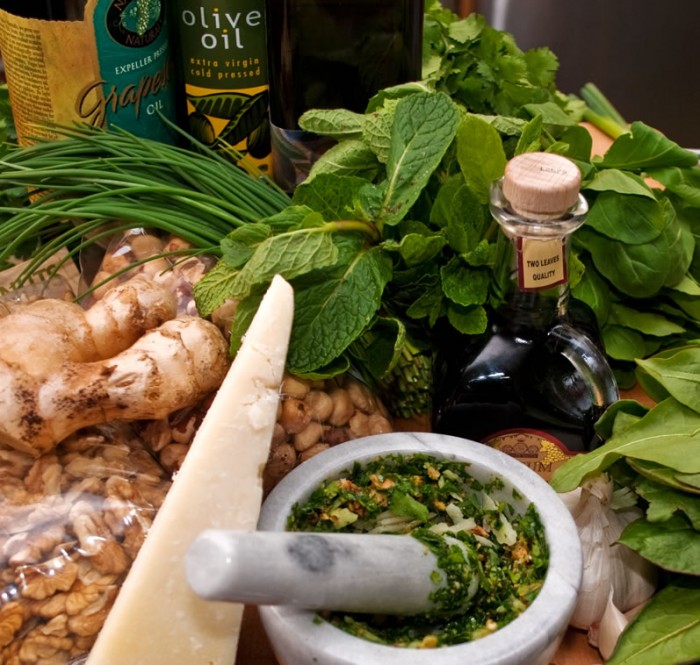

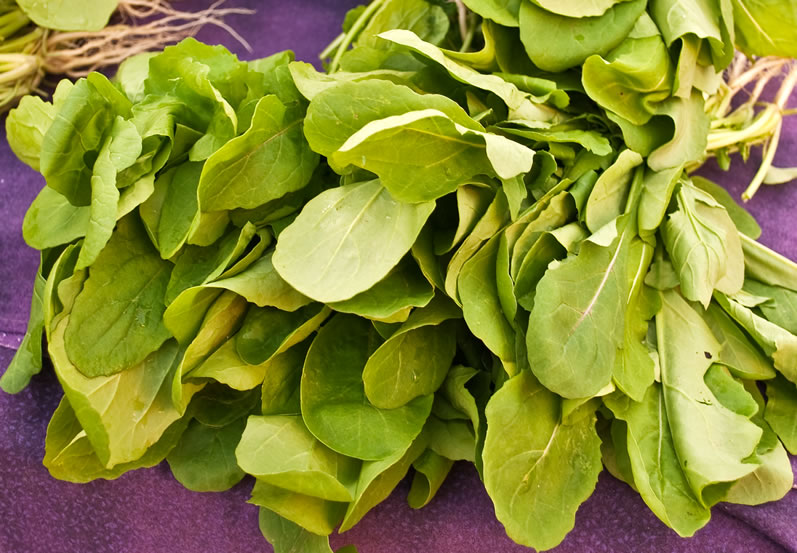
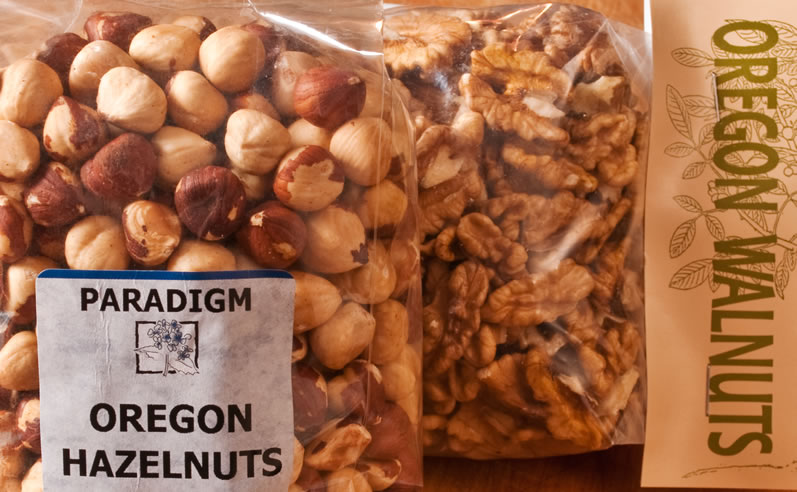
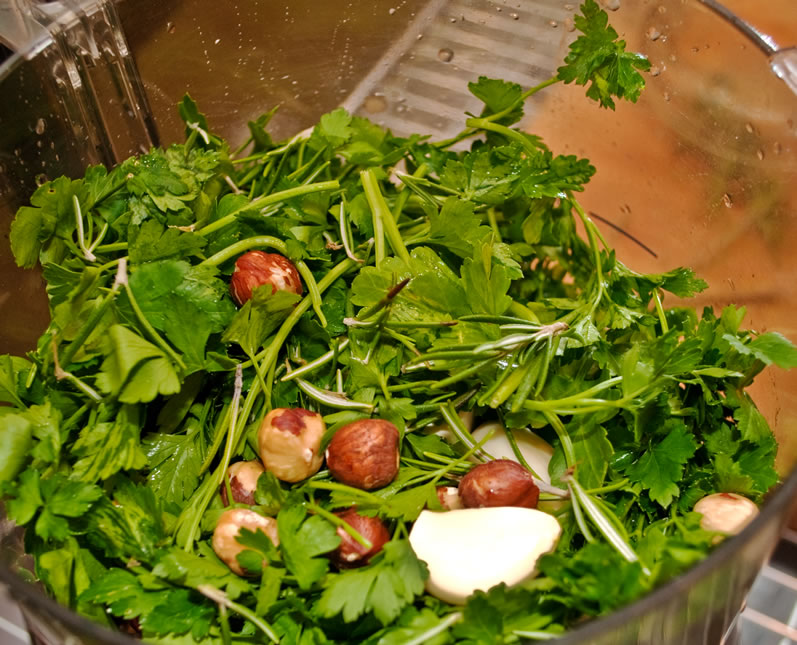
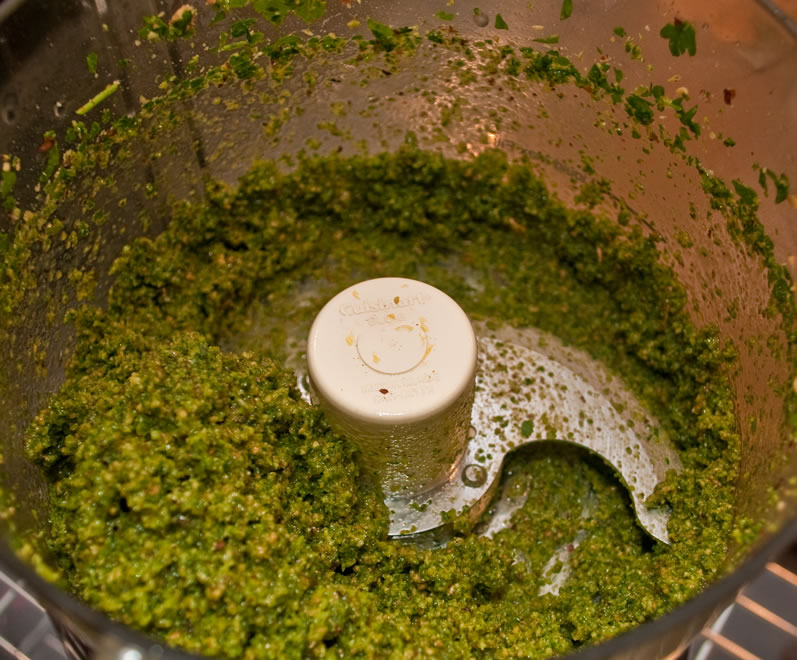
To avoid basil from discoloring when being pureed, crush a tab of vitamin C and add to basil when it is being pureed. It is an anti-oxident and wil slow discoloring for a fair period of time and imparts no taste
Herbert, thanks for the tip!
Great information! I’ve been looking for something like this for a while now. Thanks!
I make my pesto just the same as your Basil/Arugula recipe, but instead of arugula & basil, I use baby spinach. Its very good, and spinach is so healthy… try it sometime!
Yum! Fresh pesto is one of my favorite things ever. I usually make big batches and freeze portions for those overcast days when I need something springy!
.-= Bit of Butter´s last blog ..Cookbook Spotlight =-.
thanks for the green inspiration!
.-= Sarah´s last blog ..Contemporary Taiwanese Cuisine (Guest Post) =-.
Interesting fact: Pistou…in France..didn’t know.
Nice to see that you use products of high quality!
Such a farmer market is a great institution.
Greetings
.-= bobbinis-kitchen.com´s last blog ..Quarkkeulchen =-.
Oooh, thanks for a great post! Looks awesome. Love all the variations…I definitely want to try the cilantro ginger one..sounds fantastic!
.-= Sara´s last blog ..Grapefruit-Yogurt Cake =-.